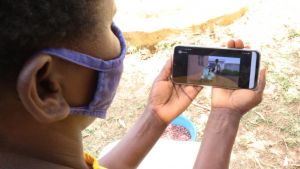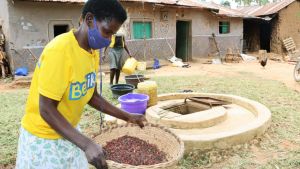Precision Development to Solve Wicked Problems

Scientific Animations Without Borders (SAWBO) uses the information highway to deliver food security results during the COVID-19 pandemic.
The primary and secondary impacts of COVID-19 have upended billions of lives globally. The health and well-being of tens of millions have been affected to date and the crisis has radically changed the economic conditions and movement patterns of billions over the past year. The impact of the pandemic on global food security efforts has created an urgent challenge for international development programs. Since the COVID-19 pandemic, global development and food security needs have skyrocketed, dramatically shifting and stretching already limited resources causing many efforts to grind to a halt or become overburdened. A great global economic reset is necessary to have any hope of averting further humanitarian crises as reduced mobility for implementers, coupled with fewer resources and increased demand, requires a rethink of how we engage in development work and achieve food security.
The grounding of global development experts and implementers has laid bare the cracks in the road in the traditional way large development organizations conduct their work – relying heavily on global or regional travel and on-the-ground presence of experts. Some travel may ultimately prove to be unavoidable, but as development entities are forced to shift to alternative delivery mechanisms, it is becoming increasingly clear that a significant amount is not.
One program, the Feed the Future Scientific Animations Without Borders Responsive-Adaptive-Participatory Information Dissemination Scaling Program, or SAWBO RAPID as it is known, is meeting this urgent challenge by bypassing traditional routes of the global development process. SAWBO RAPID’s thoroughfare creates scientific animations targeted to low literate learners from concept to target country release in an 100 percent virtual space. Early results indicate that this virtual approach is both cost efficient and is a way to push educational content into areas of the world not so easy to access otherwise.
According to the USAID Global Food Security Strategy website and USAID's Over the Horizon strategic review the world, in the past few years, has been closer than ever to ending global hunger, undernutrition, and extreme poverty, but significant challenges and opportunities remain, including urbanization, gender inequality, instability and conflict, the effects of a changing climate, environmental degradation, and setbacks have occurred due to COVID-19. Focused efforts are around three interrelated and interdependent objectives: inclusive and sustainable agricultural-led growth, strengthened resilience among people and systems, and a well-nourished population.
Reaching the Most Remote Populations
Strengthened resilience leads to self-reliance and is critical in achieving food security. Creating virtual highways like SAWBO RAPID, which don’t require person-to-person contact have the capacity to reach the most remote populations with action-oriented educational concepts that create skills that can move people from food insecure to self-secure.
Although the pandemic exposed the relatively short-term limitations of international development heavily reliant on global and regional travel, the agility with which international development entities are shifting their efforts to virtual platforms has also revealed some unanticipated benefits.
First, the long-term concern of carbon footprint associated with global travel and, consequently, global warming, represents a paradigm challenge for our traditional global-travel based international development efforts. Second, the absence of international or regional experts physically on-the-ground at implementation requires local experts to step out of the shadows of their international or regional counterparts and demonstrate or develop the capacities needed to carry projects forward leading to greater self-sufficiency.

Rhoda Mudenyo Wafula from Joyland Village, Bungoma County Kenya views the SAWBO animation on how to store beans using jerrycans.
International Development is a Wicked Problem
International development is a classic wicked problem, as described by Rittel and Webber. Lacking clear definition and therefore clear solution, it presents innumerable, ever-changing variables in ill-structured domains, that is, systems that do not conform to a standard template which must be analyzed and understood independently in order for effective action to be designed for successful implementation. We realize the wicked problems of international development have involved over a half-century of complex and nuanced discussions and debate. However, if we can take a step back and break down, at least some of, the problems of international development by thinking of these systems needing things in order to be more effective (e.g., technology, infrastructure, equipment, capital, or improved materials) and then identifying the educational steps that people can take to change behaviors and outcomes (e.g., training, education, mentoring, guided practice, etc.).
In global development, the delivery of simple solutions is often complex. Unique to this wicked problem is the innumerable cultural and sub-cultural ill-structured domains that make up the many countries, regions, and sub-regions where these solutions are needed. In addition, the significant number of low-literate learners globally require the development of solutions that do not rely on written materials. Solutions must be able to visually convey scientifically accurate expert knowledge while being culturally and linguistically appropriate in a plethora of local contexts.
It is in this latter part of the spectrum that Scientific Animations Without Borders (SAWBO) has sought, over the past decade, to create and deploy educational content that can deliver information about simple solutions to address food security and many other issues with the potential to aggregate into something bigger, thus leveraging the transformation of systems that development seeks. SAWBO takes global expertise and packages it as simple solutions in culturally and linguistically appropriate content by converting these concepts into easy-to-understand animations that can migrate across cultures and languages. These animations are then placed in SAWBO’s online library which gives free access for anyone to use SAWBO’s content for educational purposes; so they can use it where, where and how they would like to deal the challenges faced in a time, place, group, language, cultural context, etc.
By connecting a network of expert volunteers, including topic experts, language experts, and those with considerable local cultural knowledge, SAWBO is able to produce content that is specialized for specific and targeted local conditions. To date, SAWBO has produced content on over 100 topic areas and has placed it in a patchwork of over 200 languages and cultural contexts. The SAWBO library lays the groundwork for a continually expanding system for the delivery of educational solutions to many local problems for low literate learners globally while delivering these solutions entirely through digital pathways.
In the past, the development community relied on traditional transportation pathways as the way of doing business, thus relying on air travel and physical infrastructure. The fact is that traditional transportation was built to provide pathways for the function of moving people and things from one place to another, fixed installations critical for economic and independent success.

Wafula prepares to store beans using a technique she learned watching the SAWBO animation on jerrycans for bean storage.
A New Paradigm is Needed
The internet is the latest new transportation highway for the sharing of information, knowledge, entertainment, services and enabling the movement of goods. This is a rapidly expanding highway capable of reaching last-mile communities which traditional transportation cannot. And with knowledge comes power, the power to embark on a self-reliant and resilient path that can lead to food security, and improved health and livelihoods.
Over the past half-year, the SAWBO RAPID program has been exploring ways to take advantage of this internet highway towards the effective delivery of knowledge. Within Ghana, we placed content in over 15 languages, collaborating with local partners, all through online interactions, and delivered the content via YouTube ads reaching over 1 million people. Of those reached, the content was viewed in its entirety, from beginning to end, by over 50,000 people. The video shows a jerrican storage technique that allows people to use locally available containers to minimize post-harvest loss of grains in order to help them with food security, especially with all the secondary economic and food security effects of COVID-19. Within the context of YouTube, were we able to target specific language variants of these videos to places where people speak the languages overlaid on the video. Several weeks later, we were able to repeat this same precision deployment, of the same postharvest loss video, in Kenya, with over a dozen languages. We were able to target deployment of specific language variants of those animations in specific areas where those languages are spoken. This time, we reached 1.2 million people with over 60,000 people watching the entire video.
Although our efforts are preliminary, what is obvious is that virtual local collaborations to linguistically adapt content coupled with the delivery capability of internet commercial services have the long-term potential to rapidly and efficiently deliver targeted content to specific groups in their native language. This is all done without the need for physical travel or physical infrastructure other than network towers.
From a cost-benefit perspective, we were able to reach over 1 million people across Ghana for less than the cost of sending one person from the U.S. into the country for 10 days. We were able to repeat this in a second country several weeks later with the same results. Additionally, language variants of the videos were targeted to places where those languages are most often spoken, allowing for precision in their deployment. In addition, the content was delivered in less time than would be a physical trip. This virtual approach is a potential game-changer for the international development community.
Providing educational knowledge at such scale can provide a real shift in self-reliance. When considering global food security, we know that teaching proven techniques and processes are more sustainable than providing aid. We know from previous USAID-funded multi-year studies in Mozambique, through The Feed the Future Legumes Innovation Lab, that the introduction of this jerrican animation resulted in a recipient adoption rate of over 89 percent. Parallel file sharing platforms, such as WhatsApp, are now extensively used to share videos for entertainment and education. WhatsApp user groups also allow for a form of deployment precision around people with a common interest, both globally and locally. It remains to be determined the adoption rates of techniques when delivered through social media, and WhatsApp-type platforms. The fact that delivery can be done so cost effectively and independent of face-to-face human interaction is a major plus.
Certainly, one of the limitations of such an approach is that not all people have access to YouTube or similar platforms. This digital divide in some ways parallels the physical divide, where some have access but not all. However, as we look forward, the use of social media platforms has tremendous potential to rapidly deliver, and in a targeted manner, content to significant numbers of people indiscriminately, regardless of education or literacy level, in a given country on a given topic.
It also has the potential for precision targeting – right topic, right language, right audience, and perhaps most critical in the case of a crisis the right time. Key to this rapid response is the need to create and manage a library of content with enough topics in enough languages to allow for a real-time rapid response to emerging problems around the globe. Think of being able to respond to crises in your community or on the other side of the planet, with no need for travel, in minutes not in days, weeks or months. For the development community, a move to effectively use virtual highways for the delivery of key development messages is scalable and highly cost-effective and comes without the long-term sooty carbon footprint associated with physical travel.
The use of digital highways to deliver development messages, whether online or off-line, will not be a panacea for all development challenges. Additionally, what impact these social media delivery mechanisms may have in terms of people adopting the ideas presented in the videos remains to be determined. However, in the drive for global food security, the use of such approaches may allow for the scalability and rapid response with precision by topic, language, time and location in ways that were not previously possible.